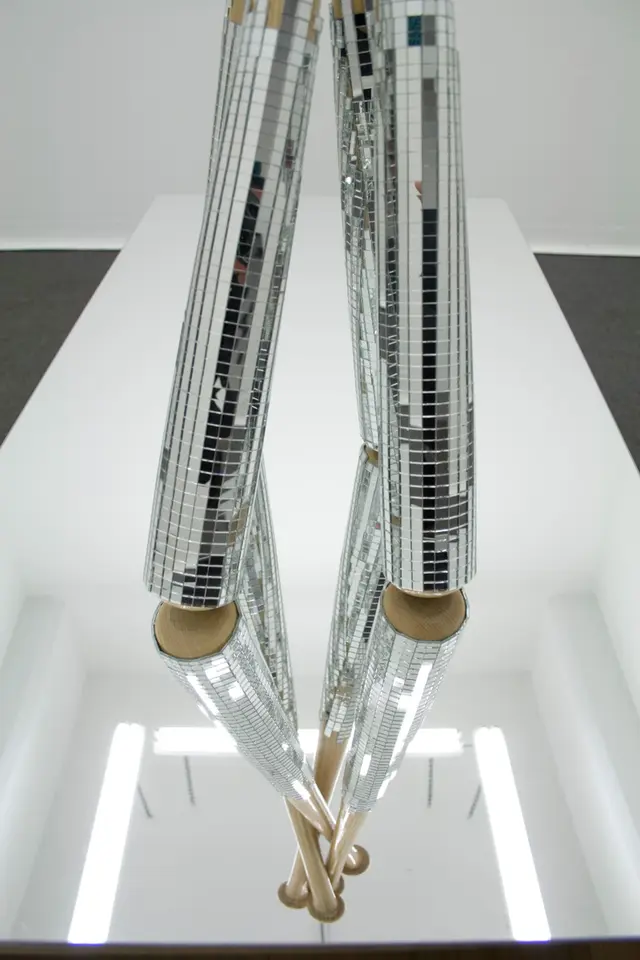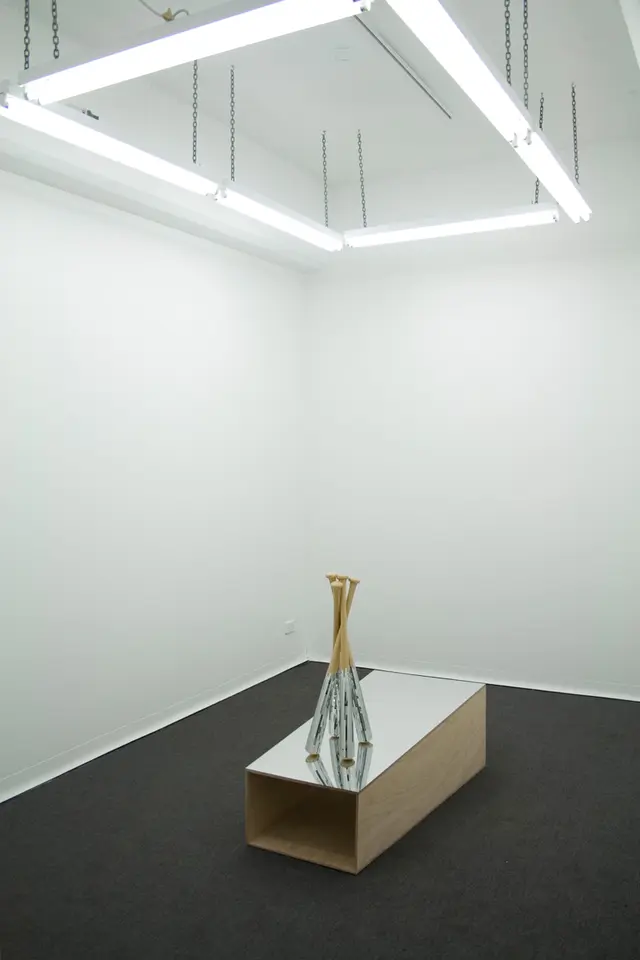“The Duel Meaning of Things”
Glenn Walls
21 Aug → 12 Sept 2009

The Duel Meaning of Things displays everyday items such as family portraits and baseball bats whose original purpose changes due to a single event or action. Referencing sixties Italian architectural group Superstudio, ‘anti design grid,’ I reconfigure mass produced objects and images to emphasis the duel purpose they can have both positively and negatively on our lives.
On the morning of February 12, 2008, Lawrence King sat quietly at his desk waiting for his computer lab class to start. At about 8:15 am, Brandon McInerney entered the room and shot King twice in the head using a .22 caliber revolver he took from his backpack. To this day McInerney has not spoken about the murder.
My practice references the application and failure of sixties Italian architecture group Superstudio’s impersonal ‘anti-design grid.’ Superstudio proposed the application of this grid to all buildings and objects such as furniture that would provide the world with one form of design that would alleviate our need to consume more things. In my works I apply this grid in the form of mirrored tiles to existing mass-produced objects in order to change their purpose and function. In doing so l personalise the object and its meaning. This reverts the object to a prototype form making comment on consumerism and sexuality.
The Duel Meaning of Things consists of mirrored grid baseball bats, referencing Superstudio’s grid. The function of baseball bats is to provide for the healthy pursuit of sport, however the positive attributes of this object is destroyed when repeatedly used in many violent bashings. The wrapping of the baseball bat’s top section in grided mirror tiles provides a reflection of ourselves as we use this object for an act it was not designed for. The baseball bats are then placed on a coffin shape structure.
Similarly the use of the family portrait as a positive reminder of loved ones is shattered when a tragic event occurs. The portrait then becomes a reminder of the circumstances surrounding someone’s violent death. Its repeated use in the media reconfigures its original intention, virtually impersonalising the victims of this story.
Again the application of Superstudio’s ‘grid’ personalises these images I have found in the media, reversing the generic intentions of the Superstudio’s ‘grid.’
Superstudio who?
Based in Florence, Superstudio were a group of young Italian architects who came together in 1966 and were disillusioned with the modernist ideal that had dominated design and architectural discourse since the early 20th century. When Superstudio proposed in the late 60’s that ‘architecture served to indoctrinate society into an irrelevant culture of consumption, and therefore sought to extract out of architecture all encumbered on man’s ability to live a free life,’ (Lang, P & Menking, W 2003, p. 13), they proposed a series of ‘histograms of architecture with reference to a grid transportable in diverse areas or scales for the edification of a nature both serene and immobile in which we might finally recognize (re-know) ourselves’ (Lang, P & Menking, W 2003, p. 19). Superstudio theory for the application of the grid to objects and architecture was to subvert the very notion of design. After all how can you keep contributing to proliferation of superfluous objects if everything looked the same?
Superstudio saw the grid as a form of anti-design. For them it was about rediscovering oneself. By homogenizing the surface, Superstudio claimed ‘every problem of space and every problem of sensibility’ (Lang, P & Menking, W 2003, p. 19), have been removed. What fascinated me about this grid was that it could be applied to anything such as chairs, tables, buildings (which they did), anything that would remove the notion of elitism through the branding of objects. According to Superstudio by removing the branding (or commercialization) of that object the notion of status relating to that object is also removed.
What Superstudio and the grid fail to take into account is our need to differentiate ourselves from each other. What l intended to show within my work was that this need to differentiate oneself from others by coding objects and spaces with personal significance allows oneself to indicate to others our preferences, our desires and our status. However as one of the members of Superstudio, Toraldo di Francia later admitted the application of the grid onto objects actually ‘initiated a new level of consumerism, and consequently another level of poverty’ (Lang, P & Menking, W 2003, p. 19). Superstudio believed that the grid could provide us with ‘auto pilot’ design. The grids application was quick, easy and functional. By using and applying the grid we would have more time to pursue the pleasures of life. The works l created using Superstudio grid show that the grid could be manipulated into various forms. This reverses Superstudio’s intentions of creating one item for all by converting mass-produced objects into individual collectables that indicate status and can be attached to narrative and memory.
Glenn Walls is just about to submit his Ph.D at RMIT University.




Glenn Walls